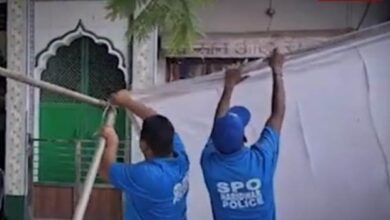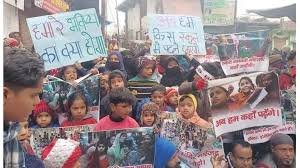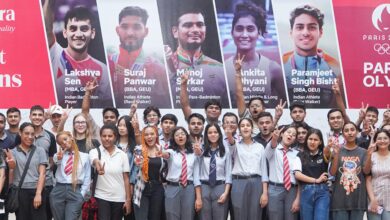Chandigarh’s Jama Masjid, the first new mosque built after partition in Punjab

Chandigarh’s Jama Masjid, the first new mosque built after partition in Punjab
S.M.A. KAZMI
Dehradun , Sept 4
A photo of Chandigarh’s Jama Masjid, shared by a childhood friend of mine, triggered a wave of nostalgia with long forgotten memories gushing back. Located in Sector-20, Chandigarh the iconic mosque was the first to be built on the Indian side of Punjab after the catastrophic division of the subcontinent along communal lines in 1947.

Interestingly, the architect who designed the mosque decided to build it along Egyptian style with the minaret rising from the marbled dome. As opposed to the Mughal style, with minaret(s) rising separately from the dome, typical of Mosques in the Indian sub-continent. maybe symbolic of a break from the past and, of new beginnings in the new city designed by famous French architect Le Corbusier. The Mosque has served the religious needs of Chandigarh’s Muslims for the past nearly half century.

My father was a central government employee who reached Chandigarh in 1962, just as the nascent city was taking shape. Ours was one of the few Muslim families settled in the city in the early sixties and the Mosque brought back fond memories of my childhood, which is when it’s construction started.

As the handful of Muslims living in Chandigarh had no place of worship, they started to hold weekly Friday congregational prayers by erecting a small tent in the open spaces more widely available in the city at the time.

However, there was no serious effort to build a mosque as the memories of bloody partition were still fresh and the migrant Muslims from Uttar Pradesh ,Bihar and elsewhere were unsure of official, and unofficial reaction. The native Punjabi Muslims living in nearby villages like Burail and Mani Majra were too scared after the partition masscare and subsequent ethnic cleansing to identify with anything Islamic and even two mosques at Burail village (sector-45) remained closed till seventies.

The Muslim Cultural Society, formed by the miniscule Muslim society comprising of migrants in city beautiful did correspond with the Capital project authorities and Deputy Commissioner, Ambala for seeking permission to hold Friday and Eid-ul-Fitr and Eid –ul Azha congregational prayers at open spaces.
Firstly, the Friday congregational prayers were held in sector-18 and then shifted to sector 20. The small Muslim community, arranged a small tent, prayer mats, tubs of water and ‘Lotas’ to perform ablutions before Friday prayers. Water being sourced from the public hydrants for abulations for the faithful attending the prayers. Incidentally, the tent stood in the ground where the mosque stands today.

In those days, the tent would be dismantled after prayers and the mats and utensils were sent to the house of the Muslims living nearby in a rickshaw to be used the week after. I remember that the tent and prayers mats used to be deposited to our home in sector 22 and the house of Anwar Ahmed Khan, owner of Swan furniture in Sector 7 who used to live in sector 18. Later, it came to be housed with Abdul Quddus Ansari of Banaras Saree emporium in sector-19 market. The annual Eid-Ul Fitr and Eid –ul- Azha prayers were also held by in the same small tent. As children, my siblings and friends looked forward to congregational prayers.

Photo by Syed Hamza Hasan
Interestingly, two unrelated developments led to the allotment of land for the mosque by the administration to Punjab Wakf Board. First being the appointment of veteran freedom fighter and Congress leader Hafiz Mohammad Ibrahim as Governor of the Punjab which in 1964 comprised the current states of Punjab, Haryana, and even parts of Himachal Pradesh. The second being the transfer of Mohd. Abdul Rahman, a senior journalist hailing from Hyderabad as a reporter of ‘ Indian Express’ newspaper to cover Punjab. The first ever ‘Id Milap’programme organised by the ‘The Muslim Cultural Society’ headed by Anwar Ahmed Khan was held on February 4, 1965 at house no-37,sector-5-A, where he stayed during those days. Kapur Singh, the then Finance Minister was the Chief Guest on the occasion which was also attended by Harbans Lal, the then Speaker of the Punjab assembly and leaders of various political parties.

The two-room rented accommodation our family was living right across Nehru Park in sector-22, was close to the office of the ‘Indian Express’, opposite sector 22-D dispensary and my father got acquainted with Mohd. Abdul Rahman due to their spatial proximity. Being a frequent visitor to the Raj Bhawan as a journalist of a national newspaper, Abdual Rahman had access to public officials and was in touch with Governor Hafiz Mohammad Ibrahim. Rahman helped the community in looking after its’ religious needs. He took permission from the administration to hold Friday and Id-ul Zuha congregational prayers at Parade ground in sector 17 in the year 1965.

My father also came to have friendly ties with the son of Governor, his namesake, Tahir. He recalled being told that as the festival of Eid was approaching, Abdul Rahman had inquired the Governor about his plans for prayer as there was no Mosque in the new city. This prompted Hafiz Mohammad Ibrahim to take up the issue with the officials of the then capital project.
A frantic search ensued to find a suitable a piece of land for the mosque and finally the parcel of land on which the Mosque stands was allotted to Punjab Wakf Board. While Hafiz Mohammad Ibrahim was removed as a governor in September 1965 and Abdul Rahman returned to the national capital after covering the Indo-Pakistan war of 1965, their twin contributions to the Muslim community of Chandigarh were to have a lasting impact.
A six kanal plot of land was allotted to then Punjab Wakf Board for a price of Rs.14,000 in sector-20 by the Estate Officer in 1966. It was the collective effort of the small Muslim community of the city for its’ religious needs which fructify in getting a Muslim graveyard and a mosque in City beautiful. Anwar Ahmed Khan of Swan furniture fame, Shaukat Ali, an advocate who was a member of the Punjab Wakf Board, Abdul Qudoos Ansari of Banaran Saree Emporium,sector-19 and Abdul Qyoom of ‘Embassy Footwear’ in sector-20-D worked wholeheartedly for the community and its’ needs.
Although I was only six years old, I vividly remember one evening in 1969 when my father came rushing home and asked me to take a bath. I was given a white kurta-pajama to wear and my father took me on his bicycle to the vacant plot of land in Sector-20. A few Muslims, some members of the Punjab Wakf Board, Maulana Abdul Aziz from Islamic seminary of Mazahar Uloom, Saharanpur, and the architect of the mosque from New Delhi, were present. Being a child, I was perplexed at the strange company that I found myself in.
I was chosen to be the first to dig at the groundbreaking. The spade being rather heavy for a six-year-old, my hitting the earth was limited to being symbolic. Others present followed suit. The solemn ceremony was followed by the pre-dusk, ‘Asr’ prayer, one of the last congregations to be conducted on open ground. Although it took over two decades to complete the mosque due to a plethora of challenges, that fateful day marked the birth of the Mosque.
Later, when I asked my father that why I was chosen to have the first go at the ground breaking ceremony, he explained that the elders decided that to circumvent any potential conflict between community members competing to be first. Therefore, it was suggested that a child from the community should be given the honor to which everyone present agreed. My father asked to bring his young boy for the occasion, which was unanimously agreed to.
The construction of the Sector-20 Jama Masjid commenced at a snail’s pace in the early seventies. The Punjab Wakf Board faced the additional challenge of finding an Imam for the Mosque as many were appointed but none stayed for long. Later, Maulana Ajmal Khan, a cleric from Mewat area of Haryana was appointed as Imam of the mosque, who remains the Imam of the Mosque to this day. My father arranged for both me and my elder brother to visit the mosque every day in the afternoon after school to study Quran and Urdu from Maulana Ajmal.

I remember as it was yesterday, what an adventure the ride on my elder brother’s bicycle from Sector-22 to the mosque felt like then, half a century ago. We would take the stretch of old Ropar-Kalka Road, the remnants of which used to pass through sector-21, with desi mango trees lined on both sides. That old road has been swallowed by the ever-expanding city. While we dreaded the stick of the Maulana, we enjoyed playing in the precincts of the mosque as it was being built. For nearly three decades, I prayed in the mosque with my father till I was transferred out of town in 1990.
Most interestingly, while Mohd. Abdul Rahman worked in Indian Express newspaper at various places in the country as a reporter , I myself served the ‘The Indian Express’ as a journalist at various places in north India.
The Almighty has strange ways.






